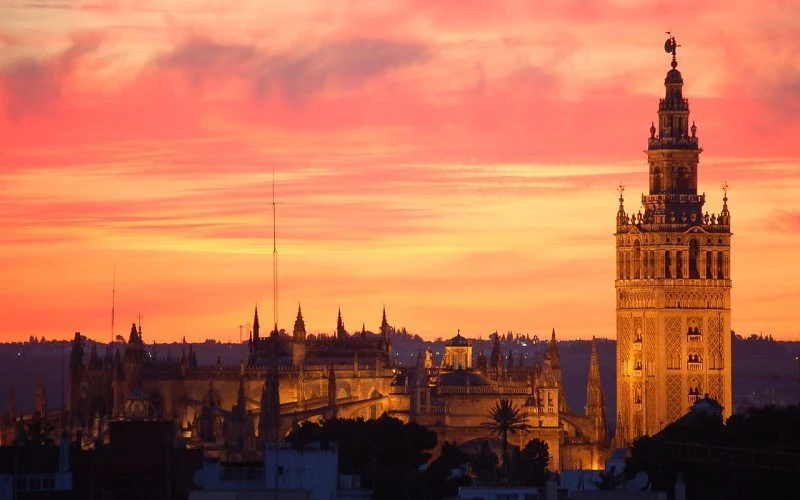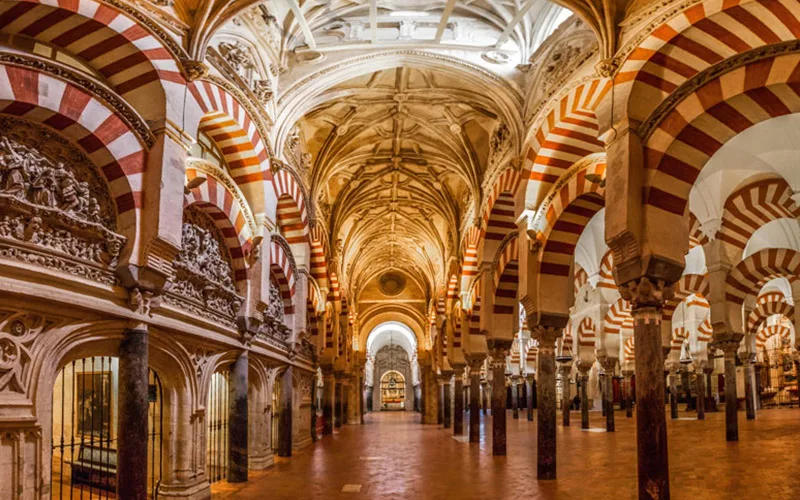1. Seville: A Typical Andalusian City
Romantic, dazzling and sensual, Seville is the quintessential Andalusian City. Colorful religious festivals and the famous flamenco dance are ingrained in its distinctive culture. Travelers are in love with the city's traditional vibe, with quaint cobbled streets and elegant squares surrounded by beautiful architecture. At night, the historic center is illuminated by old street lamps, which gives it a special atmosphere.
The most important architectural monument in Seville and its main attraction is the Cathedral, which was converted from the Great Mosque and is the largest Gothic church in the Christian world. Seville, like the rest of Andalusia, is characterized by Moorish architectural relics in the Mudejar style, such as the Alcazar with its lush gardens, fountains and fragrant orange trees.
Another attraction is the Santa Cruz area, with its winding alleys and picturesque courtyards. This medieval quarter was the old Jewish district and is now the most charming and tourist area of Seville and is worth visiting with a sightseeing tour in the first place. On a sunny day or pleasant evening, visit the Maria Luisa Park and relax in Plaza de España, or enjoy a leisurely boat ride through the park's canal.
 |
| Seville Typical Andalusian City, Andalusia Landmarks |
2. Granada: The Last Fortress of the Moors
When the Moors arrived from the deserts of North Africa in the 13th century, they were overwhelmed by the lush landscape of Granada. At the foot of the Sierra Nevada mountains, the abundant water from the Rio Darro has provided the locals with rich vegetation and the opportunity for intensive farming. The Moors built a remarkable fortress on the top of the Alhambra hill here, and crowded fountains were placed throughout the city as a symbol of wealth.
A masterpiece of Islamic design, the Alhambra is magnificent primarily for its landscaping, rose gardens and waterways. Granada continued to flourish as a Moorish city until the 15th century. When the Catholic monarchs conquered the city in 1491, Granada was the only remaining stronghold of Moorish rule in Andalusia. The last Sultan Boabdil is said to have wept as he cast his last glimpse into the beautiful landscape of Andalusia.
The Alhambra as well as the Albaycín area (Old Islamic City) are included in the UNESCO World Heritage List for their cultural and historical value. Apart from these, the city's attractions are the colorful Arabian spice market and traditional Arabian baths. Other attractions include the Renaissance Cathedral and Capillo, where Catholic monarchs are buried.
 |
| Granada: The Last Fortress of the Moors, Andalusia Landmarks |
3. Ronda
Ronda stuns visitors with its dramatic views and wild landscapes. This magnificent city, built over a steep ravine, is the characteristic Pueblo Blanco or "white city of Andalusia" with whitewashed houses clinging to the cliff top. Proud of its traditional Andalusian culture, Ronda has the second oldest bullring in Spain. The Plaza de Toros is still used for bullfighting. The Goyesque Festival features a classic bullfight and a parade of people in costumes from the 18th century, from the era of Francisco De La Goya.
Ronda is a beautiful city full of Old World charm. Tourists will enjoy exploring the picturesque streets of La Quidad, the historic Moorish town of Ronda. On sunny days, the city parks are ideal for walking along tree-lined paths and relaxing in the shade. The parks Alameda del Tajo and Alameda de José Antonio offer panoramic views of the surrounding landscape. To discover another corner of Ronda's legacy, visit the Bandit Museum, which illustrates the history of these brave antiheroes of the region.
 |
| Ronda Spain, Andalusia Landmarks |
4. Grand Mosque of Cordoba: UNESCO World Heritage Site
In the 10th century, Cordoba was the capital of the Caliphate of Cordoba, the Mauritanian kingdom that ruled most of the Iberian Peninsula. While Paris and Rome were in the dark ages, Cordoba was the most important city in Europe. The city was the center of civilization, where the great scientists Maimonides (Jewish philosopher) and Averro (Muslim philosopher) shared their ideas, and a place where people of three religions, Christianity, Islam and Judaism lived in harmony.
A must-see attraction in Cordoba is the UNESCO-listed Grand Mosque, with its breathtaking interior, forest of Islamic arches and columns. Known as the Mesquita , or Cordoba Cathedral Mosque , this monument is one of the most magnificent Islamic buildings ever built. The historic quarters of Cordoba are located around the mosque. The Old Jewish Quarter (Judería) is a particularly atmospheric neighborhood with narrow pedestrian streets, quiet courtyards and whitewashed houses decorated with flowers. The area is famous for its beautiful courtyards, and many residents decorate them with colorful potted flowers. In May, the entire city of Cordoba comes alive with the Competition de Patio, a live festival, competition for the most beautiful courtyard.
 |
| Great Mosque of Cordoba, Andalusia Landmarks |
5. Beaches of Marbella
Marbella is a charming seaside resort on the Costa del Sol. The picturesque whitewashed town is located next to fantastic sandy beaches and lovely palm tree promenades. As a trendy holiday city, Marbella has a variety of golf courses and private clubs that cater to tourists from all over the world. However, Marbella is not just a beach destination, but also interesting monuments and great art museums.
The historic center is a charming old Moorish village with many lovely surprises hidden among the cobblestone streets. Tourists will love the discovery of exquisite little 16th-century churches and quiet courtyards with relaxing outdoor cafes. Plaza de Los Naranjos (Orange Square) is filled with restaurant terraces and fragrant orange trees. Marbella is also interesting for cultural attractions such as the Museum of Modern Engraving in Spain, which displays works by Goya, Picasso, Miro and Salvador Dali.
 |
| Marbella, Andalusia Landmarks |
6. Andalusian Traditions in Jerez de La Frontera
Proud of its heritage, Jerez de la Frontera (35 km from Cadiz) is an aristocratic city with a sophisticated atmosphere. The city is best known for its Andalusian breeding horses and attracts many travelers who come here to see traditional horse shows. The Andalusian Riding School (Royal Andalusian Riding School) in an elegant building on Avenida de Duc de Abrantes hosts the popular show, the Andalusian Horse Dance. And in May, a 500-year-old horse fair is held.
Jerez de la Frontera is famous for the traditional Andalusian art of flamenco dance and cante jondo (deep song). Kante jondo is a dramatic and memorable style of gypsy singing. The landmark of the city is the Centro Andaluz de Documentación del Flamenco Palace ,located in Plaza San Juan, in the Palacio de Pemartin. This beautiful 18th century mansion is well worth a visit to admire its exquisite architecture, in particular the lovely Baroque-Rococo courtyard. In late February and early March, the annual Festival de Jerez presents traditional as well as avant-garde flamenco performances of exceptional quality at the Teatro Villamarta and other venues.
 |
| Jerez de La Frontera, Andalusia Landmarks |
7. Ancient Port City of Malaga
Malaga is an ancient Mediterranean port city and has ancient fortresses. Perched on a hilltop overlooking the bay, the Alcazaba and Castillo de Gibralfaro overlook the city and harbor and offer stunning views of the coastline. Malaga is a true anomaly on the Costa del Sol among an endless stretch of beach resorts because it is a true Spanish working-class city.
Those looking for a simple beach holiday should stick to the nearby beaches, but travelers with an interest in culture will enjoy Malaga. This pleasant seaside town has fascinating ancient ruins, beautiful gardens and a fantastic Picasso museum, as well as several other fine museums. The historic city center is also a delightful place with its charming Old World atmosphere. While exploring the narrow pedestrian streets, visitors will find attractive small boutiques and plazas filled with terraced tapas restaurants.
 |
| Malaga, Andalusia Landmarks |
8. Renaissance Architecture in Úbeda
Among the picturesque olive groves along the Guadalquivir River lies the town of Úbeda. It is famous for its Renaissance architecture. Thanks to the harmonious architectural unity, the city was named "Andalusian Salamanca", a Spanish city famous for its beautiful historic buildings.
The central attraction of Úbeda is the long Piazza Vasquez Molina, surrounded by remarkable Renaissance buildings. The main attraction is the 16th-century Church of El Salvador on the northeastern side of the square. The church has a richly sculpted façade with two round towers. The interior features a semicircular chapel with an impressive dome, a superb choir and a retablo with a carved transformation by Alonso Berruguete.
 |
| Renaissance Architecture in Ubeda |
9. Historical Sites and Old World Charm in Baeza
The historic town of Baeza is located in the Guadalquivir Valley at the foot of Mount Loma de Úbeda, surrounded by olive groves and corn fields. Baeza has an ancient Roman, Moorish and Christian heritage and has retained its Old World charm. In the 16th century, Baeza became an important trade center and university town. The prosperity of Baeza during the Middle Ages can be seen in beautiful old houses and noble mansions. The spacious Paseo de la Constitucion in the center of Baeza dates back to the 17th century. The Plaza de Los Leones, on the western side of the Paseo de la Constitucion, was named after the fountain in the center of the square that includes four lion figures.
 |
| Baeza, Andalusia Landmarks |
10. Pueblos Blancos
The Pueblos Blancos, or white towns, are charming tourist destinations located nonstop in the hills of Andalusia. Picturesque hilltop villages are scattered throughout the unspoiled natural landscape of Andalusia, with stunning views of the snow-capped mountains and lush green valleys. The villages are characterized by their quaint whitewashed houses clustered on the hillsides, influenced by the simple Berber aesthetic of the Moors who came from North Africa. Colorful potted flowers, narrow cobblestone streets and lovely little churches add to the charm. The city of Ronda is the most dramatic Pueblos Blancos, famous for its bullfighting as well as stunning landscapes.
11. Jaén
The Andalusian city of Jaén lies at the foot of the Sierra de Jabalcus and Sierra de La Pandera, where the hills are covered with vast olive groves. The province of Jaén is one of the largest olive regions in the world. Steeped in history, Jaén emerged as a walled Carthaginian city, and during the Roman Empire was an area of silver mining. During the Moorish era, Jaén was the capital of the Islamic Kingdom of Jayan, recaptured by Christian armies in 1492.
The most important place in Jaén is Jaén Castillo de Santa Catalina, a castle that stands majestically on an impressive rocky hilltop. This old Moorish stronghold was captured in 1246 by order of King Ferdinand III. The beautifully restored castle has been converted into a luxury hotel. The hotel's rooms are decorated in a traditional Andalusian style and offer panoramic views of the surrounding area. The magnificent Arabic-style dining room serves traditional regional cuisine, including Pipirrana (mixed vegetable salad) and Ensalada de Perdiz (partridge salad).
 |
| Jaén, Andalusia Landmarks |

